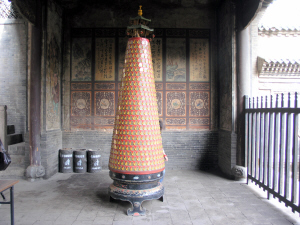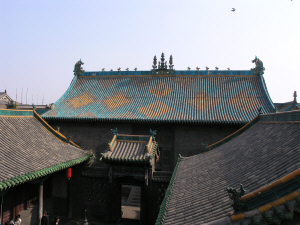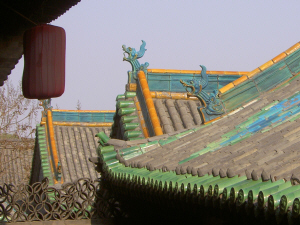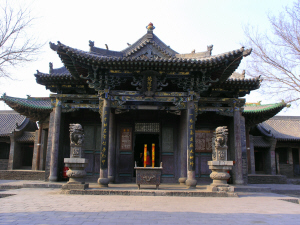|
Friday April 3rd, 2009 |
Pingyao,
Sunny Max: 15; Min: 3; Avg: 9 |
We had a good nights sleep - here like all hotels in China the beds were hard,
but rather that than soft beds which we sometimes find at hotels in Europe. We
breakfasted on pancakes, omelette and toast, spoke to the waitresses and decided
to set off for a trip along the wall that surrounds Pingyao.
The wall was originally built almost 3000 years ago to fend off enemies. The
original wall was built of earth and mud, but the current wall was rebuilt and
expanded in 1370, this time of stones and bricks. The total length is 6,4km,
there are 6 gates, 72 towers and 3000 crenels, the top of the wall is 5m wide
and it is 10m high.
It felt much warmer today, the sun was shinning and it was perfect weather to go
for a long walk. The wall around the wall was very peaceful, we met no more than
20 people and had some great views of life within and outside the wall, and the contrast
between the new - outside the wall - and the old - inside the wall. There were
large areas within the wall that were now derelict (but often still lived in!), and it didn't seem as though
there were any plans to build anything. However it was easy to imagine the life
there must have been just 50 years ago with all the small alleyways, low houses
surrounding courtyards and the main thoroughfares.
It took us just about 2 hours to make the 6,4km trip, starting and ending at the
southern gate (Yingxun Gate). We arrived at the northern gate just as the
children were let out of school, most (if not all) going home for lunch and
greeted with a firework display - why we have no idea, but we'd heard the
fireworks the day before as well, so it seemed to be a daily thing. On the rest
of the trip we could see mothers preparing food, often in outdoor kitchens.
The commercial centre of Pingyao seemed to be outside the west gate and partly to
the north, whilst on the
eastern and southern side; there were some smaller communities - also walled
in, but with mud and earth walls.
One gets a good idea of Pingyao daily life as one walks around the wall -
children playing, mothers cooking or washing clothes and hanging them up to dry
- how on earth they keep them clean with all the dust flying about, we had no idea
- lots of older men sitting around in groups and playing cards or
Chinese checkers; workers collecting bricks from some of the more derelict building
probably to shore up their own homes, mechanics repairing old tractors and
three wheel lorries trying to get a few more kilometres out of them.
Things lie everywhere bricks, rubble, coal, wood and more waiting for good
use sometime in the future and dust, dust and more dust, everything brown and
grey they certainly need some rain before the heat sets in!
We left the wall at the same place we'd started and made our way back to the
hotel, stopping for a drink
and more interest in Yanemi and Daji. We bought water and ice cream before on the way
to the hotel paying a 50% premium on top of what Chinese per paying for ice
cream - but it was still cheap!
After a short rest we set off to visit two more Temples - the Chenghuang Temple and the
Gingxuguan Temple Taoist Temple - we were tired of courtyard houses and wanted
to see some colour. The Chenghuang Temple (or the Temple of the City God) is
located in the southeast corner of the city next to the Cofucian Temple we'd
visited the previous day. It is supposedly one of the most well preserved
temples in China, covering an area of 7,302 square meters and contains elaborate
woodcarvings, stone sculptures, and beautiful mural paintings. The temple
actually is two temples, the Temple of the City God, Caishen (god in charge of
fortune in Chinese legends), and Zaojun (god in charge of food) Temple. The
roofs have a shiny blue and green glaze, which give the temple a certain
grandeur. The temple encompasses the Hall of the City God, a Theatre Hall, and
a Sleep Hall.
According to legend, the Hall of City God was the court for the gods, so the
atmosphere boosts a grandiose and serious aura. The most notable feature in the
hall is the city god who sits upright in the shrine with judges and ghosts
standing to his side. In addition one exhibit must be taken directly from a Hollywood
horror movie with figures being sawed in half, hung, crushed, pulled apart and
more. I'm not sure what it is to depict, but perhaps some of the punishments the
City God could initiate.
The Qingxu Temple, was of less interest as it now is a Museum, rather than a
temple This Taoist temple was a place where eminent people and scholars
frequently visited to study and meditate on the Taoist teachings. Qingxu Temple
was first built in Tang Dynasty and prospered in the Yuan Dynasty, occupying
over 6,000 square meters. The museum is split into three parts: Taoist
civilization, the history of Pingyao, and cultural relics. As we left the temple
there was water all over the place. We assumed a water pipe had broken until we
realised that a hose had been used to try and get a cat down from a tree - but
only managed to drive the cat further up.
We walked back to the hotel. There were significantly more people on the streets
today, both Chinese and foreign tourists. It was too early for dinner, so we
took a drink before deciding where to eat. An hour later and most restaurants
were still fairly empty, but we eventually found one that looked
promising and was packed.
It turned out that the restaurant was full of a group of ca. 50 French tourists
- most of them sitting with their coats and jackets on. We soon found out why,
the room was freezing, and even wearing coats, we were still cold. At least the service was proficient and the food arrived quickly,
but wasnt particularly good. Disappointed with the food and cold, Lene
was wondering where we could find a cake, when a very large birthday cake arrived for one of the
members of the French group. We sang along on the birthday song to keep warm,
whilst we were waiting for the bill. In a very nice gesture, the person who was
celebrating his birthday and cutting the cake, came with four pieces of cake for
our table as well. So Lene had her wish fulfilled.
It seemed warmer outside than in, and we took our time walking back to the hotel.
We ordered coffee at the hotel bar, and sat and played a few rounds of Uno. We
learnt that Uno was unknown in China, but the waitresses knew the game due to
the many foreigners that had stayed at the hotel.
NEXT
DAY (4th)
|
















































